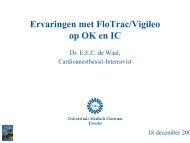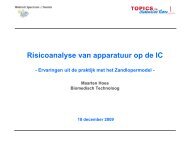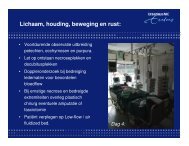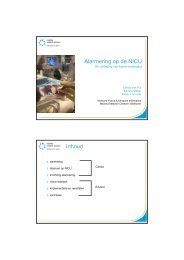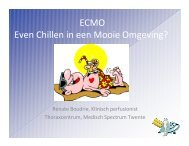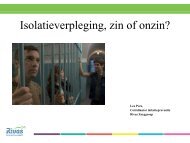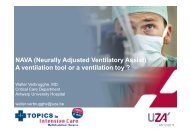Abstract 1 - Topics in Intensive Care
Abstract 1 - Topics in Intensive Care
Abstract 1 - Topics in Intensive Care
You also want an ePaper? Increase the reach of your titles
YUMPU automatically turns print PDFs into web optimized ePapers that Google loves.
Implementation of daily goals <strong>in</strong> the ICU reduces length of ICU stay and errors of omission <strong>in</strong> patient<br />
care.<br />
J.M. B<strong>in</strong>nekade 1 ; A. Brunsveld 2 ; S. Arbous 2 ; M.G.W. Dijkgraaf 3 ; J. Horn 1 ; J.A.P. van der Sloot 1 ; A. Balzereit 2 ; M.B.<br />
Vroom 1<br />
Academic Medical Center, Amsterdam, The Netherlands: 1 Department of <strong>Intensive</strong> <strong>Care</strong> Medic<strong>in</strong>e; 3<br />
Department of Epidemiology and Biostatistics<br />
Leiden University Medical Center, Leiden, The Netherlands: 2 Department of <strong>Intensive</strong> <strong>Care</strong> Medic<strong>in</strong>e<br />
Introduction<br />
In ICU, daily goals have improved the effectiveness of communication with<strong>in</strong> care teams (1). Study<br />
objective: to <strong>in</strong>vestigate the effect of explicit daily goals <strong>in</strong> ICU practice on the length of <strong>in</strong>tensive care stay,<br />
length of hospital stay, duration of mechanical ventilation and errors of omission <strong>in</strong> patient care.<br />
Methods<br />
A multicenter, sequential cohorts pretest‐posttest study was performed. Dur<strong>in</strong>g the pre‐test phase daily<br />
goals were formulated by staff‐physicians, evaluated by a research physician and kept bl<strong>in</strong>ded for the rest<br />
of the ICU‐team. Subsequently, daily goals were broadly implemented. Dur<strong>in</strong>g the post‐test phase daily<br />
goals were rout<strong>in</strong>e practice. Patient data were collected one full year before (as basel<strong>in</strong>e reference) and<br />
dur<strong>in</strong>g the pre‐ and post‐test phases. Dur<strong>in</strong>g pre‐ and post‐test medical charts (random subsets of 10<br />
patients a week) were reviewed for errors of omission, def<strong>in</strong>ed as deviations from our care protocols.<br />
Patient data were compared to data from non participat<strong>in</strong>g academic ICU’s, extracted from the National<br />
<strong>Intensive</strong> <strong>Care</strong> Evaluation database.<br />
Results<br />
Two academic ICU’s participated <strong>in</strong> the study. Patients <strong>in</strong>cluded: basel<strong>in</strong>e reference n=3641; pretest<br />
n=3401, and post‐test 3426. ICU mean (sd) length of stay (days) differed significantly between pre‐test<br />
phase, 5.7(2) and post‐test phase 4.3(2.3), difference 1.4 days (95% CI 1.3/1.5). Contrary to the other<br />
academic ICU’s the APACHE II score <strong>in</strong>creased dur<strong>in</strong>g the study period (figure 1 and 2). The post‐ICU<br />
length of hospital stay decreased <strong>in</strong> the post‐test phase, mean difference 2.3 days (95% CI 1.2/3.4).<br />
Median (IQr) duration of mechanical ventilation dur<strong>in</strong>g pre‐test 2 (1‐4) days and dur<strong>in</strong>g post‐test 1 (1‐4)<br />
days, p < 0.001. The probability of an error of omission was significant larger <strong>in</strong> the pre‐test phase then <strong>in</strong><br />
the post‐test phase, RR 6.5 (5.7/7.4).<br />
Discussion<br />
The results showed a significant decrease <strong>in</strong> ICU‐LOS, duration of mechanical ventilation and length of<br />
post ICU stay follow<strong>in</strong>g DGF implementation. Also the chance of errors of omission to occur was 6 times<br />
lower which <strong>in</strong>dicates a significant <strong>in</strong>crease <strong>in</strong> protocol adherence. The drawback of study design (historic<br />
control group and a pre and post test for comparison) was limited by compar<strong>in</strong>g the study results with<br />
other academic centers dur<strong>in</strong>g the same time frame.<br />
References:<br />
1. Pronovost PJ et al. J Crit <strong>Care</strong> 18: 71‐75; 2003<br />
Reference<br />
Study group<br />
Other Academic hospitals<br />
Study<br />
Reference<br />
Other Academic hospitals<br />
Study group<br />
<strong>Abstract</strong> 24



